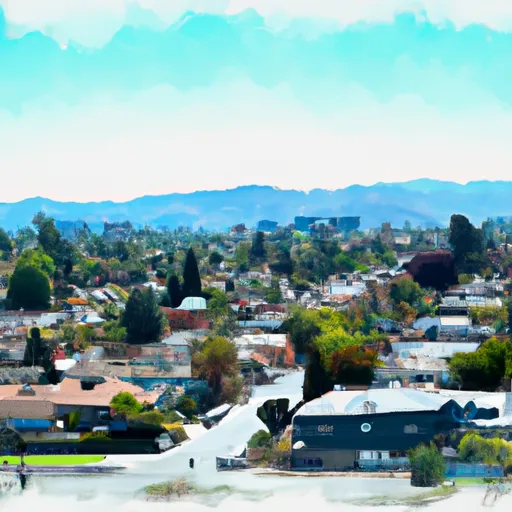-
 Snoflo Premium
Snoflo Premium
Get unlimited access to all our content
With no Ad interruptions! - Start Your Free Trial Login with existing account
Spring-Valley-La
Eden Index
Climate
8.6
•
Recreation
6.9
•
Community
2.1
•
Safeguard
6.4/10

Spring Valley is a suburban community located in San Diego County, California. Known for its mild and pleasant climate, Spring Valley experiences warm summers and mild winters. The Mediterranean climate brings average temperatures ranging from the mid-60s to mid-70s Fahrenheit, with occasional hot spells in the summer reaching the 80s. Winters are typically mild, rarely dropping below the mid-40s. The area receives around 10 inches of rainfall annually, primarily occurring during the winter months.
As for hydrology constituents, Spring Valley is home to several reservoirs and lakes, including Sweetwater Reservoir and Lake Jennings. These bodies of water not only supply water to the region but also offer opportunities for fishing, boating, and picnicking. The surrounding landscape is characterized by rolling hills, providing a picturesque backdrop for outdoor enthusiasts.
Outdoor recreation opportunities in Spring Valley are abundant. The area features numerous parks and trails, such as Spring Valley Community Park and the Sweetwater River Trail, which offer opportunities for hiking, biking, and birdwatching. Additionally, nearby mountains and nature preserves provide opportunities for more adventurous activities like rock climbing and camping. With its pleasant climate and proximity to natural landscapes, Spring Valley offers a variety of outdoor recreation options for visitors and residents alike.
What is the Eden Index?
The Snoflo Eden Index serves as a comprehensive rating system for regions, evaluating their desirability through a holistic assessment of climate health, outdoor recreation opportunities, and natural disaster risk, acknowledging the profound impact of these factors on livability and well-being.
Climate Health Indicator (CHI): 8.6
Spring-Valley-La receives approximately
203mm of rain per year,
with humidity levels near 72%
and air temperatures averaging around
16°C.
Spring-Valley-La has a plant hardyness factor of
8, meaning
plants and agriculture in this region tend to thrive here all year round.
By considering the ideal temperature range, reliable water supplies, clean air, and stable seasonal rain or snowpacks, the Climate Health Indicator (CHI) underscores the significance of a healthy climate as the foundation for quality living.
A healthy climate is paramount for ensuring a high quality of life and livability in a region, fostering both physical well-being and environmental harmony. This can be characterized by ideal temperatures, reliable access to water supplies, clean air, and consistent seasonal rain or snowpacks.
Weather Forecast
Streamflow Conditions
Northern Mojave
Area Rivers
Northern Mojave
Snowpack Depths
Northern Mojave
Reservoir Storage Capacity
Northern Mojave
Groundwater Levels
Recreational Opportunity Index (ROI): 6.9
The Recreational Opportunity Index (ROI) recognizes the value of outdoor recreational options, such as parks, hiking trails, camping sites, and fishing spots, while acknowledging that climate plays a pivotal role in ensuring the comfort and consistency of these experiences.
Access to outdoor recreational opportunities, encompassing activities such as parks, hiking, camping, and fishing, is crucial for overall well-being, and the climate plays a pivotal role in enabling and enhancing these experiences, ensuring that individuals can engage in nature-based activities comfortably and consistently.
Camping Areas
| Campground | Campsites | Reservations | Toilets | Showers | Elevation |
|---|---|---|---|---|---|
| Mojave Narrows Regional Park | 69 | 2,749 ft | |||
| Mojave River Forks Regional Park | 65 | 3,163 ft | |||
| Applewhite | 44 | 3,306 ft | |||
| Dogwood | 93 | 5,739 ft | |||
| El Mirage Dry Lake OHV | None | 2,887 ft | |||
| Glen Helen Regional Park | 47 | 1,993 ft | |||
| Hesperia Lake Park | None | 2,937 ft | |||
| Silverwood Lake State Rec Area | 131 | 3,373 ft | |||
| Adelanto City Park | 21 | 2,891 ft |
Catastrophe Safeguard Index (CSI):
The Catastrophe Safeguard Index (CSI) recognizes that natural disaster risk, encompassing floods, fires, hurricanes, and tornadoes, can drastically affect safety and the overall appeal of an area.
The level of natural disaster risk in a region significantly affects safety and the overall livability, with climate change amplifying these risks by potentially increasing the frequency and intensity of events like floods, fires, hurricanes, and tornadoes, thereby posing substantial challenges to community resilience and well-being.
Community Resilience Indicator (CRI): 2.1
The Community Resilience Indicator (CRI) recognizes that education, healthcare, and socioeconomics are crucial to the well-being of a region. The CRI acknowledges the profound impact of these elements on residents' overall quality of life. By evaluating educational resources, healthcare accessibility, and economic inclusivity, the index captures the essential aspects that contribute to a thriving community, fostering resident satisfaction, equity, and social cohesion.

